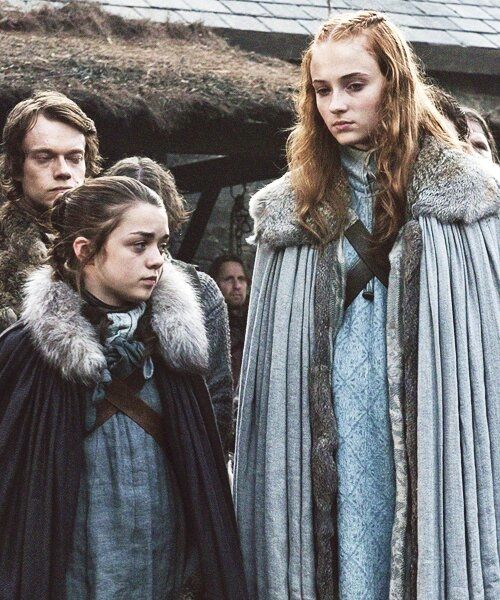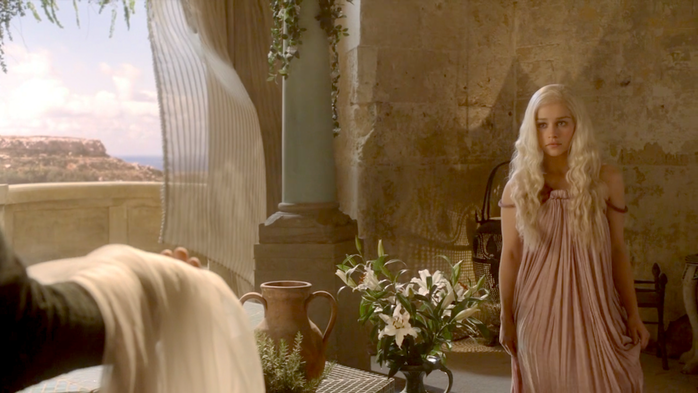A Look Back on the Costumes from Game of Thrones
- Ash McKay

- Sep 14, 2022
- 7 min read
Updated: Feb 13, 2023

I’m fascinated by how we can understand characters based on their costumes. What do the style, colour and details say about each character? When creating my costumes and characters, this exercise gets me thinking about how I can show a character's journey with their costume. In this post, I’ve looked at four prominent women in the HBO series Game of Thrones: Arya, Sansa, Cersei and Daenerys. I’ll mainly be focusing on Season 6 and the season 7 premiere… aka the last time I publicly called myself a fan (we don’t talk about season 8 in my house.) During the series, the show slowly shifted focus from the men who ran the kingdoms to the women in the shadows pulling the strings. They each fought a unique battle to rise and claim a seat at the table. When we examine their costumes, we can see a reflection of each character’s transformation.
Arya
Arya started the series being pulled in different directions. She was supposed to be a young lady. During important occasions, she was dressed in minute versions of her sister’s outfits. Her outfits were possibly even passed down from Sansa when Sansa had outgrown them. Arya wore heavy blue-dyed wool dresses and capes trimmed with thick furs, suited to the frigid temperatures of the north. When left to her own devices, Arya often wore outfits more like her brothers: linen tunics, pantaloons and padded skirts. We can see her dressed like this during her sword fighting lessons with Syrio in King’s Landing.

After her father’s beheading, she escapes the city disguised as a boy and leaves behind the feminine clothing completely. In her decision to abandon the city, she also left behind the pressure to conform and become a “proper lady.” Her outfits became practical for the long road ahead of her: her hair cut short, skirts traded for pants and a roughspun tunic. These would become her staple garments for much of the show as she travelled across Westeros and on to Braavos.

In the season 7 opening, Arya had the most unassuming costume of the four women present in that episode. This is an example of how her time spent training with the Faceless Men affected her outward appearance. She used those skills of disguise and deception to cross the country unnoticed by the enemy, exacting her revenge.

Travelling through the forest on horseback, Arya wore cloaks of black and brown over dark wool clothing. These cloaks blended in with the forest background, like the chameleon she was. She kept her sword, “Needle”, visible while she sat and chatted with the Lannister Soldiers. She was presented as not too clean, not too dirty, clothing not too nice, but not too ragged. Arya looked neither rich nor poor. She was completely unremarkable in the way she looked, allowing her to assume any position needed. Her enemies were none the wiser about what she was thinking and who she was. A few seasons earlier she could not pull this off as well as she did in season 7. Arya was hidden in plain sight.
Sansa

Sansa went through hell in season 6. After being forced into marriage with Ramsay Bolton and then escaping, viewers followed her big return to her ancestral home with Littlefinger’s army. With her return in the premiere, we only see glimpses of what she wore: heavy fur cloaks like her brother and her people. Under the fur cloak was a leather corset that looked like an armoured piece. The bodice of the dress was sewn to look like plate armour, suggesting a military influence.

On the shoulders of the dress, Sansa had big squared-off epaulettes, reaffirming the militaristic theme of her dress, but also her position. Her half-brother may have been King of The North, but she was the head of the House of Stark. She no longer wore her hair in the style of the Southerners. She styled her hair similarly to how she wore it when she was younger and how her mother, Catelyn Stark, wore hers.

The most prominent part of her outfit was her necklace “Needle”. The gold ring against her dark outfit gleamed bright, especially in the bleak setting of the north. The chain and sewing needle swung from her hip. Sansa has had her Needle necklace since the end of season four. The name and where she wore it mirrored her sister Arya and her sword “Needle,” suggesting solidarity amongst sisters that once had difficulty seeing eye to eye.
Sansa was a naive, hopeless romantic teenager at the beginning of the series. She preferred pastel colours and soft silk textiles for her dresses. Joining the court in King’s Landing, Sansa was quick to adopt Southern hairstyles and dress. She seemed relieved to be able to shed her “backwaters” style, for a more fashion-forward dress. This is another example of her over-romanticisation of the court. Sansa was too young and too naive to realize the corruption and depravity that existed within the walls of King’s Landing.
While returning to the North with Petyr Baelish, known as Littlefinger, we saw Sansa shed the southern style. As she travelled with Littlefinger, we saw how he influenced her style, with what I call “the Mockingbird dress.” The Mockingbird is the Baelish’s sigil. This cloak is also influenced by Littlefinger’s style, with the high collar, fur trim and diamond tweed patterning.
In the premiere, we saw a return to Northern Style dress, Sansa’s way. She was committed to her people and her role in protecting them, but on her terms, without outside influence.
Cersei
Cersei started season one by vying for power in the way that was allowed for women. She used poison to kill her enemies and sent out spies to do her bidding. Once she lost the last ties to the woman she was supposed to be, Cersei decided to take matters into her own hands the way a man in her position would have expected. She put herself on the Iron Throne and commanded the army from the battlements, no longer relegated to ruling the kingdom from the shadows.
The first outfit Cersei wore in season 7 was a black leather dress with diamond cutouts over a twill salt and pepper dress. It gives the appearance of a dress made of chainmail. Her new hairstyle makes her features appear harsher in contrast to her long feminine hairstyles from previous seasons.
The black leather dress was simple when juxtaposed with her outfits of earlier seasons, which usually featured billowing sleeves, big statement jewellery and ornate embroidery. Earlier season outfits tended to be softer in appearance as well with the Japanese kimono influence, soft fabrics and rich colours.
In the next scene, we saw Cersei in a grey twill dress with very interesting detailing on the shoulders and along the neckline of the dress. It looked like a gorget and shoulder armour with intricate details, including the fierce lion head. A gorget is neck armour, sometimes with intricate gilded designs.

(Elaborately decorated gilt-brass gorget of c. 1630, probably Dutch) (Source for Picture of Gorget [https://en.wikipedia.org/wiki/Gorget])

The lion heads were seen on Jamie’s shoulder armour in the same place, making no mistake that Cersei's dress details were meant to be a part of her armour, just like Jamie’s. It also signified that Jamie and Cersei were still a matching set. Although, Jamie had yet to decide if he was standing with his sister or not in the war.
Cersei had another notable visual change over the seasons. Her long flowing hair was forcibly chopped short by the Septas in the previous season. Her hair, the metaphorical representation of her femininity, like her children, the physical representation, had been taken away from her. Cersei said she wished she had been born a man, and through losing everything she once held dear, she had been reborn and made herself King.
Daenerys
Daenerys’s dresses are always my favourites. The details in her dresses are always beautiful and reflective of her journey. As her dragons grew and Daenerys’ came into her queen-ness, her dress details looked more like dragon scales. This dark earth-brown dress was no exception. There were so many different details to get into with this outfit, such as the beads and embroidery on her epaulettes and her sleeves, which looked like dragon scales.

I use the term dress loosely because Daenerys is wearing pants under the dress, seen through the double-leg slits. The double high-cut slits at the front bring the ease of movement she needed for the battles in Westeros. Her epaulette-shoulder armour mirrored what her Unsullied army wore, creating a visual connection with the army she led. The elements of her costume were softened with a Kimono-inspired neckline, which gave her an elegance that contrasted with the harsh lines of Cersei Lannister's dress. Daenerys had a great regal cape hanging off her back. Everything about this outfit said “Queen Conqueror.”
Daenerys’s great claim to fame in the east was releasing the slaves and raising them in status as equals to their former masters. You can see this visually by her Handmaid and advisor Missandei. She wore the same style of leather armour dress as Daenerys. Missandei was seen by Daenerys as someone fit to stand by her side and wear the same uniform as her, regardless of Missandei’s upbringing as a slave girl.
Daenerys’s transformation is as dramatic as Cersei’s. In season one, Daenerys is a shy, virginal girl in a gauzy pale dress being sold off to a warlord. She then lost her husband and her ability to birth children. She was reborn in fire and adopted the freed slaves and dragons as her children. Where the linen dresses left her vulnerable and exposed, her leather armour dress protected and concealed her.
Conclusion
Each of these powerhouse women of the Game of Thrones series had their own unique transformation. What they had in common was losing a part of themselves and all that they held dear to find the power they needed to rule. They each started the show playing support to a man’s hero journey, but each, in turn, took over the show for themselves, as well as conquered their corner of Westeros.
Michele Clapton has been the Costume Designer for seasons one through five and returned for seasons seven and eight, with April Ferry taking on as lead Costume Designer for season six. Their efforts have not gone unnoticed. The show has won eleven awards and been nominated six times just for Costume Design. The internet, myself included now, has taken note of the depth of detail Clapton and her team had put into every piece. Search Game of Thrones costumes and there is a pile of interviews and articles picking apart every detail of the embroidery and how it adds to the story of the character wearing it.
As an aspiring costume designer, I had great joy watching the show unfold through the story of its clothing.
I want to know what your favourite GoT costume is! Tell me in the comments below!

Sources & Additional Reading
Source on Sansa [https://www.bustle.com/articles/85163-sansa-starks-fashion-evolution-through-game-of-thrones-and-how-her-wardrobe-mirrors-her-character]
For more information about Sansa Stark’s transformation shown through her clothing [https://www.bustle.com/articles/85163-sansa-starks-fashion-evolution-through-game-of-thrones-and-how-her-wardrobe-mirrors-her-character]
[http://clothesonfilm.com/game-of-thrones-costume-evolution-sansa-in-black/35654/]
Source for Picture of Gorget [https://en.wikipedia.org/wiki/Gorget]
Read more about Cersei Lannister [http://clothesonfilm.com/game-of-thrones-costume-analysis-cersei-lannister/32970/]
More about Daenerys [http://clothesonfilm.com/game-of-thrones-costume-analysis-daenerys-targaryen/32665/]
















































Comments